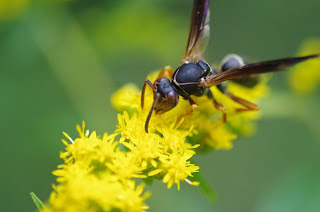Backyard Bugs of the Day:
Eastern tiger swallowtail butterfly, female (I think).
And male (I think). Notice the difference in the amount of blue on the hind wings -the females have more.
So, how is this noteworthy? First, it's unusual for me to get such a clear shot of the dorsal side of one of these butterflies - they usually keep their wings up at least a bit. But to get a clear shot of both female and male in one day? Unprecedented. But there's more...
You can see it in the picture above as well, but this female butterfly has some pretty serious damage to her wings. And yet, she can still fly - and quite well, from what I saw. Butterflies' wings won't grow back if they are damaged, but they can still fly with some pretty big chunks removed, as you can see. The farther along a butterfly gets in its lifespan (and it can be as little as a couple of weeks, depending on the species), the more likely that the wings will be kind of ragged. Even the male has some damage - the 'tails' that make a swallowtail distinctive are broken off, which is pretty common damage for swallowtails - not surprising, really, that's a delicate thing sticking out there. You can see that the female has at least part of one of her tails left.
And what else?
This picture and the next show how much competition there is for nectar - both show bees wanting to be on the same flower as the butterfly. I have seen butterflies chased off by bees, and vice versa. And bees chased off by other bees. And in general there can sometimes be a bit of squabbling for space on a flower. Many of the pictures I took of this butterfly had out-of-focus bees in the background (sometimes more than one).
Here she's sharing with several beetles, but none of them seemed to mind. The bugs do sometimes share.
So, what else do we have for butterflies today...
A skipper
And another skipper
And other Lepidoptera:
These moths are suddenly quite abundant. Especially in the garden shed.
Tiny moth that I didn't realize was a moth until I looked at it through the lens.
Primrose moth.
This is but a portion of the butterflies and moths I saw in the backyard today. The cooperative portion. I saw quite a few swallowtails, and got a good enough look at some of them to see that they were not tiger swallowtails. They flitted right over my head, but would not pose for me.
And Lepidoptera Larvae:
And here it is in the afternoon, having turned more white, and now brown instead of green. How strange it must be to change colors every couple of days.
It has been eating a lot the last two days, but this afternoon it was walking around a lot, and in the evening, after dark, it was gone. I think it has probably gone off to find somewhere to pupate. Caterpillars often leave the place they have been eating to become a chrysalis. There's probably a metaphor in there somewhere...
Do you remember that I said yesterday that the second largest of these caterpillars would turn green today?
Here it is in the morning...
... and here it is in the early afternoon...
... And here it is later in the afternoon. Green.
Now, for the other caterpillars on that same tree:
Near neighborsJust to show how many caterpillars there are on this tree, I took this (bad) picture. It's mostly one per leaf - not on every leaf of the tree, but in certain areas.
The largest of the furcular caterpillars, the one that spent all day yesterday on the bottom of a leaf, spent all day today eating. It ate the leaf it was on yesterday (and these are big leaves) and then worked on several others throughout the day.
And speaking of furculas, and trees with a lot of caterpillars...
This little sapling has a lot of little caterpillars. You can just barely see three of them here.
This is what they look like. I don't know if this is a different species than the ones on the other tree, or if this early instar looks totally different in coloring. They do behave the same, though, whipping their tails around.
White hickory tussock moth caterpillar.
The eastern tiger swallowtail caterpillar is also starting to turn green...
... and it has developed its false eye spots.
I wanted to be organized about this today, but I have had some technical difficulties, and am running out of time (and may have to post before I am finished, and then go back and add more), so...
At random, Random Bugs:
Last summer these huge bees were attracted to these flowers; it was the first time the flowers really bloomed in profusion. This summer they are back - the flowers and the bees - and what is interesting to me is that I have never seen these huge bees on any other kind of flower, not even the ones in the same flowerbed.Net winged beetle
Assassin bug nymph
I think this hopper has been in the exact same spot for days.
It may not be a safe spot - see the assassin bug nymph? See the (out of focus) hopper?
Katydid, immature. Note the wings that are not fully developed.
Cricket
Wasp
Still no idea what this is
Hoverfly
A couple of crickets that were attracted to the crumbs of my lunch. I am glad I checked the box before I brought it in the house with crickets in it. They can be very loud indoors.
Wasp - It might be a cuckoo wasp, but I have never seen one so small.
Wasp
Arachnid Appreciation:
.
.
.
.
.
.
.
.
.
.
.
.
Jumping spider
So small...













































No comments:
Post a Comment